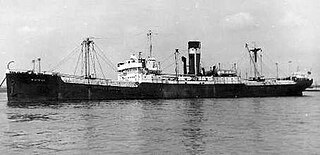
SS Clan Campbell was a British cargo steamship. She was built for Clan Line Steamers Ltd as one of its Cameron-class steamships. She was launched at Greenock in 1937, served in the Second World War and was sunk in the Mediterranean in 1942.
SS Volo was a British steam cargo ship that was built on Tyneside in 1938 and sunk by a German U-boat in the Mediterranean Sea off North Africa in 1941. 23 people on board the Volo died as a result of the attack.

SS Clan Alpine was a UK steam cargo liner. She was launched in 1918 and sunk by a U-boat in 1943.

SS Clan Macwhirter was a British cargo steamship. She was built in 1918 as Ypresville in the First World War and sunk by enemy action in 1942 in the Second World War. In her 24-year career she also carried the names Halizones and Willcasino.

SS Clan Fraser was a British cargo steamship. She served in the Second World War and was bombed and sunk in Greece in 1941.

The Cameron-class steamships were a class of UK cargo twin-screw steamships. They were designed for Clan Line and were also used by Scottish Shire Line and the Royal Navy.

The SS Clan Forbes was a British cargo steamship. She was built for Clan Line Steamers Ltd as one of its Cameron-class steamships. She was launched at Greenock in 1938, served in the Second World War and was scrapped in Hong Kong 1959.

SS Empire Brigade was a 5,184 GRT cargo ship that was built in 1912 as SS Hannington Court. She served through the First World War and was sold in 1936 to Achille Lauro, who renamed her Elios. In 1940 when Italy declared war on France and the United Kingdom she was interned by the UK as a war prize and taken over by the Ministry of War Transport (MoWT), which renamed her Empire Brigade. Four months later she was torpedoed and sunk by U-99.

SS Blairspey was a steam cargo ship that was built in Scotland in 1929 and served in the Battle of the Atlantic in the Second World War. In 1940 she survived being part of Convoy SC 7 and managed to reach port, despite being hit by at least three torpedoes from two different U-boats. The ship was rebuilt with a new bow and renamed Empire Spey 1942. Her original name was restored in 1946. She was renamed Evandros 1961 and scrapped in Italy in 1967.
SS Beatus was a British cargo steamship that was built in 1925, sailed in a number of transatlantic convoys in 1940 and was sunk by a U-boat that October.

SS Soesterberg was a Dutch-owned cargo steamship that was built in Belgium in 1927 and sunk by a U-boat in 1940 in the Battle of the Atlantic.

SS Aenos, formerly SS Cedar Branch, was a British-built cargo steamship. She was completed in England in 1910 and sunk in the Battle of the Atlantic in 1940.
Empire Cameron was a 7,015 GRT cargo ship which was built in 1941 for the Ministry of War Transport (MoWT). She was sold in 1946 and renamed St Margaret. In 1960, she was sold and renamed Agna, serving until scrapped in 1963.
Empire Comet was a 6,914 GRT cargo ship that was built in 1940 by Lithgows Ltd, Port Glasgow for the Ministry of War Transport (MoWT). She was torpedoed and sunk by U-136 in June 1941.
SS Burgondier was a 5,297-ton cargo steamship built to a First World War standard design by Caird & Company at Greenock on the Firth of Clyde. She changed owners and names several times, becoming the Azul, David Dawson, Penteli and finally Brockley Hill. She was sunk by enemy action in 1941.
SS Hertford was a refrigerated cargo steamship that was launched in Germany in 1917, seized by the United Kingdom in 1920 as World War I reparations, and sunk by a U-boat in 1942 with the loss of four members of her crew.
SS Clan Macarthur was a British refrigerated cargo steamship. She was built for Cayzer, Irvine and Company's Clan Line Steamers Ltd as one of its Cameron-class steamships. She was launched in Greenock in 1936 and sunk in the Indian Ocean by enemy action in August 1943.
SS Clan Macalister was a Clan Line heavy-lift cargo liner. She was launched in 1930 in Scotland and sunk by enemy aircraft during the Dunkirk evacuation in 1940 with the loss of 18 of her crew. She was the largest ship to take part in the Dunkirk evacuation.
SS Clan Macfadyen was a UK steam cargo liner. She was launched in 1923 and spent her entire career with Clan Line. A U-boat sank her in 1942 with the loss of 82 lives.
SS Algarve was a Danish cargo steamship that was built in 1921 for DFDS. After Germany invaded Denmark in April 1940 Algarve was transferred to the UK Ministry of War Transport. In 1941 an E-boat sank her with all hands in the North Sea.











